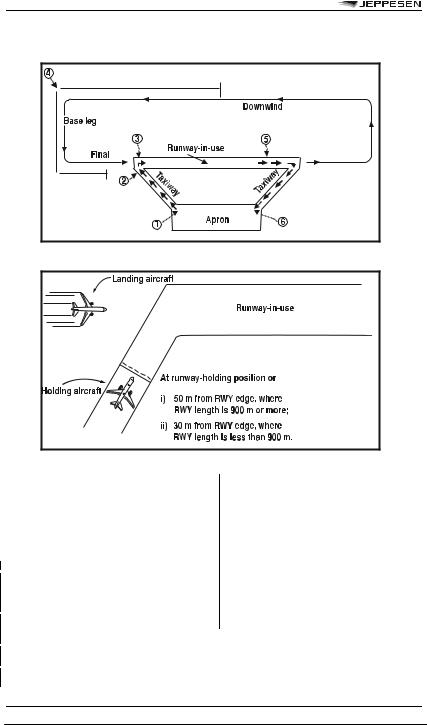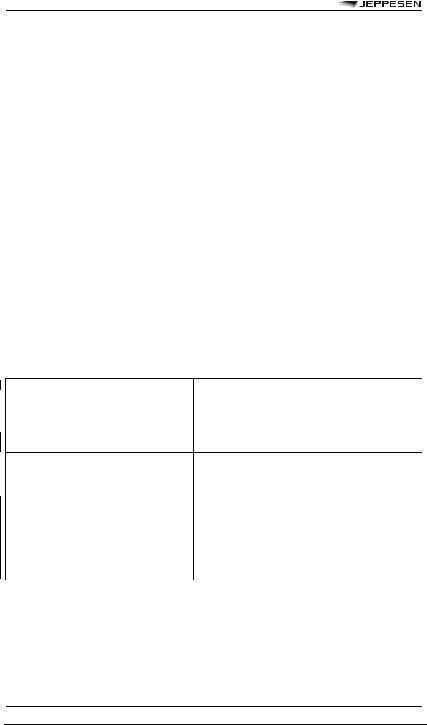
AIR TRAFFIC CONTROL
.pdf
4 SEP 09 |
AIR TRAFFIC CONTROL |
407 |
AIR TRAFFIC MANAGEMENT (DOC 4444)
5.10.1.2 Essential traffic information shall be given to controlled flights concerned whenever they constitute essential traffic to each other.
NOTE: This information will inevitably relate to controlled flights cleared subject to maintaining own separation and remaining in visual meteorological conditions and also whenever the intended separation minimum has been infringed.
5.10.2 Information to Be Provided
Essential traffic information shall include:
a.direction of flight of aircraft concerned;
b.type and wake turbulence category (if relevant) of aircraft concerned;
c.cruising level of aircraft concerned; and
1.estimated time over the reporting point nearest to where the level will be crossed; or
2.relative bearing of the aircraft concerned in terms of the 12-hour clock as well as distance from the conflicting traffic; or
3.actual or estimated position of the aircraft concerned.
6SEPARATION IN THE VICINITY OF AERODROMES
6.3.3Departure Sequence
6.3.3.1 Departing aircraft may be expedited by suggesting a take-off direction which is not into the wind. It is the responsibility of the pilot-in-command of an aircraft to decide between making such a take-off or waiting for normal take-off in a preferred direction.
6.5PROCEDURES FOR ARRIVING AIRCRAFT
6.5.2Standard Clearances for Arriving Aircraft
6.5.2.3Contents
Standard clearances for arriving aircraft shall contain the following items:
a.aircraft identification;
b.designator of the assigned STAR;
c.runway-in-use, except when part of the STAR description;
d.initial level, except when this element is included in the STAR description; and
e.any other necessary instructions or information not contained in the STAR description, e.g. change of communications.
6.5.2.4Descent Below Levels Specified in a STAR
6.3PROCEDURES FOR DEPARTING When an arriving aircraft on a STAR is cleared to
AIRCRAFT
6.3.2Standard Clearances for Departing Aircraft
6.3.2.1General
The appropriate ATS authority should, wherever possible, establish standardized procedures for transfer of control between the ATC units concerned, and
descend to a level lower than the level or the level(s) specified in a STAR, the aircraft shall follow the published vertical profile of a STAR, unless such restrictions are explicitly cancelled by ATC. Published minimum levels based on terrain clearance shall always be applied.
6.5.3Visual Approach
© JEPPESEN, 2000, 2009. ALL RIGHTS RESERVED.

408 |
AIR TRAFFIC CONTROL 4 SEP 09 |
AIR TRAFFIC MANAGEMENT (DOC 4444)
6.5.3.5 For successive visual approaches, separation shall be maintained by the controller until the pilot of a succeeding aircraft reports having the preceding aircraft in sight. The aircraft shall then be instructed to follow and maintain own separation from the preceding aircraft. When both aircraft are of a heavy wake turbulence category, or the preceding aircraft is of a heavier wake turbulence category than the following, and the distance between the aircraft is less than the appropriate wake turbulence minimum, the controller shall issue a caution of possible wake turbulence. The pilot-in-command of the aircraft concerned shall be responsible for ensuring that the spacing from a preceding aircraft of a heavier wake turbulence category is acceptable. If it is determined that additional spacing is required, the flight crew shall inform the ATC unit accordingly, stating their requirements.
6.5.4Instrument Approach
6.5.4.1 The approach control unit shall specify the instrument approach procedure to be used by arriving aircraft. A flight crew may request an alternative procedure and, if circumstances permit, should be cleared accordingly.
6.5.4.3 If visual reference to terrain is established before completion of the approach procedure, the entire procedure must nevertheless be executed unless the aircraft requests and is cleared for a visual approach.
6.5.5Holding
6.5.5.5 Holding and holding pattern entry shall be accomplished in accordance with procedures established by the appropriate ATS authority and published in AIPs. If entry and holding procedures have not been published, or if the procedures are not known to a flight crew, the appropriate air traffic control unit shall specify the designator of the location or aid to be used, the inbound track, radial or bearing, direction of turn in the holding pattern as well as the time of the outbound leg or the distances between which to hold.
6.5.5.9 If an aircraft is unable to comply with the published or cleared holding procedure, alternative instructions shall be issued.
6.5.6Approach Sequence
6.5.6.1General
The following procedures shall be applied whenever approaches are in progress:
6.5.6.1.1 The approach sequence shall be established in a manner which will facilitate arrival of the maximum number of aircraft with the least average delay. Priority shall be given to:
a.an aircraft which anticipates being compelled to land because of factors affecting the safe operation of the aircraft (engine failure, shortage of fuel, etc.);
b.hospital aircraft or aircraft carrying any sick or seriously injured person requiring urgent medical attention.
c.aircraft engaged in search and rescue operations; and
d.other aircraft as may be determined by the appropriate authority.
6.5.6.1.2 Succeeding aircraft shall be cleared for approach:
a.when the preceding aircraft has reported that it is able to complete its approach without encountering instrument meteorological conditions; or
b.when the preceding aircraft is in communication with and sighted by the aerodrome control tower and reasonable assurance exists that a normal landing can be accomplished; or
c.when timed approaches are used, the preceding aircraft has passed the defined point inbound and reasonable assurance exists that a normal landing can be accomplished;
NOTE: See 6.5.6.2.1 concerning timed approach procedures.
d.when the use of an ATS surveillance system confirms that the required longitudinal spacing between succeeding aircraft has been established.
6.5.6.1.4 If the pilot of an aircraft in an approach sequence has indicated an intention to hold for weather improvement, or for other reasons, such action shall be approved. However, when other holding aircraft indicate intention to continue their approach-to-land, the pilot desiring to hold will be cleared to an adjacent fix for holding awaiting weather change or re-routing. Alternatively, the aircraft should be given a clearance to place it at the top of the approach sequence so that other holding aircraft may be permitted to land. Coordination shall be effected with any adjacent ATC unit or control sector, when required, to avoid conflict with the traffic under the jurisdiction of that unit or sector.
6.5.6.2Sequencing and Spacing of Instrument Approaches
6.5.6.2.1TIMED APPROACH PROCEDURES
6.5.6.2.1.1 Subject to approval by the appropriate ATS authority, the following procedure should be utilized as necessary to expedite the approaches of a number of arriving aircraft:
a.a suitable point on the approach path, which shall be capable of being accurately determined by the pilot, shall be specified, to serve as a check point in timing successive approaches;
b.aircraft shall be given a time at which to pass the specified point inbound, which time shall be determined with the aim of achieving the desired interval between successive landings on the runway while respecting the applicable separation minima at all times, including the period of runway occupancy.
6.5.6.2.1.2 The time at which aircraft should pass the specified point shall be determined by the unit providing approach control service and notified to the aircraft sufficiently in advance to permit the pilot to arrange the flight path accordingly.
© JEPPESEN, 2000, 2009. ALL RIGHTS RESERVED.

4 SEP 09 |
AIR TRAFFIC CONTROL |
409 |
AIR TRAFFIC MANAGEMENT (DOC 4444)
6.5.6.2.1.3 Each aircraft in the approach sequence shall be cleared to pass the specified point inbound at the previously notified time, or any revision thereof, after the preceding aircraft has reported passing the point inbound.
6.6INFORMATION FOR ARRIVING AIRCRAFT
6.6.1 As early as practicable after an aircraft has established communication with the unit providing approach control service, the following elements of information, in the order listed, shall be transmitted to the aircraft, with the exception of such elements which it is known the aircraft has already received:
a.type of approach and runway-in-use
b.meteorological information, as follows:
1.surface wind direction and speed, including significant variations;
2.visibility and, when applicable, runway visual range (RVR);
3.present weather;
4.cloud below 1500m (5000 ft) or below the highest minimum sector altitude, whichever is greater; cumulonimbus; if the sky is obscured, vertical visibility when available;
5.air temperature;
6.dew point temperature, inclusion determined on the basis of a regional air navigation agreement;
7.altimeter setting(s);
8. any available information on |
signifi- |
cant meteorological phenomena |
in the |
approach area; and |
|
9.trend-type landing forecast, when available.
c.current runway surface conditions, in case of precipitants or other temporary hazards;
d.changes in the operational status of visual and non visual aids essential for approach and landing.
6.6.4 At the commencement of final approach, the following information shall be transmitted to aircraft:
a.significant changes in the mean surface wind direction and speed;
NOTE: Significant changes are specified in Annex 3, Chapter 4. However, if the controller possesses wind information in the form of components, the significant changes are:
–Mean head-wind component: 19km/h (10 kt)
–Mean tail-wind component: 4km/h (2 kt)
–Mean cross-wind component: 9km/h (5 kt)
b.the latest information, if any, on wind shear and/or turbulence in the final approach area;
c.the current visibility representative of the direction of approach and landing or, when provided, the current runway visual range value(s) and the trend.
6.6.5 During final approach, the following information shall be transmitted without delay:
a.the sudden occurrence of hazards (e.g. unauthorized traffic on the runway);
b.significant variations in the current surface wind, expressed in terms of minimum and maximum values;
c.significant changes in runway surface conditions;
d.changes in the operational status of required visual or non-visual aids;
e.changes in observed RVR value(s), in accordance with the reported scale in use, or changes in the visibility representative of the direction of approach and landing.
6.7OPERATIONS ON PARALLEL OR NEAR-PARALLEL RUNWAYS
6.7.2Departing Aircraft
6.7.2.1Types of Operation
Parallel runways may be used for independent instrument departures as follows:
a.both runways are used exclusively for departures (independent departures);
b.one runway is used exclusively for departures while the other runway is used for a mixture of arrivals and departures (semi-mixed operation); and
c.both runways are used for mixed arrivals and departures (mixed operation).
6.7.2.2Requirements and Procedures for Independent Parallel Departures
Independent IFR departures may be conducted from parallel runways provided:
a.the runway centre lines are spaced by the distance specified in Annex 14, Volume I;
b.the departure tracks diverge by at least 15 degrees immediately after take-off;
c.suitable surveillance radar capable of identification of the aircraft within 2km (1.0 NM) from the end of the runway is available; and
d.ATS operational procedures ensure that the required track divergence is achieved.
6.7.3Arriving Aircraft
6.7.3.1Types of Operations
6.7.3.1.1 Parallel runways may be used for simultaneous instrument operations for:
a.independent parallel approaches; or
b.dependent parallel approaches; or
c.segregated parallel operations.
6.7.3.2Requirements and Procedures for Independent Parallel Approaches
6.7.3.2.1 Independent parallel approaches may be conducted to parallel runways provided that:
a.The runway centre lines are spaced by the distance specified in Annex 14, Volume I; and
1.where runway centre lines are spaced by less than 1310m but not less than 1035m, suitable secondary surveillance radar (SSR) equipment, with a minimum
© JEPPESEN, 2000, 2009. ALL RIGHTS RESERVED.

410 |
AIR TRAFFIC CONTROL 4 SEP 09 |
AIR TRAFFIC MANAGEMENT (DOC 4444)
azimuth accuracy of 0.06 degrees (one sigma), an update period of 2.5 seconds or less, and a high resolution display providing position prediction and deviation alert, is available; or
2.where runway centre lines are spaced by less than 1525m but not less than 1310m, SSR equipment with performance specifications other than the foregoing may be applied, provided they are equal to or better than those stated under 3. below, and when it is determined that the safety of aircraft operation would not be adversely affected; or
3.where runway centre lines are spaced by 1525m or more, suitable surveillance radar with a minimum azimuth accuracy of 0.3 degrees (one sigma) and an update period of 5 seconds or less is available;
b.Instrument landing system (ILS) and/or microwave landing system (MLS) approaches are being conducted on both runways;
c.the missed approach track for one approach diverges by at least 30 degrees from the missed approach track of the adjacent approach;
d.an obstacle survey and evaluation is completed, as appropriate, for the areas adjacent to the final approach segments;
e.aircraft are advised of the runway identification and ILS localizer or MLS frequency as early as possible;
f.vectoring is used to intercept the ILS localizer course or the MLS final approach track;
g.a no-transgression zone (NTZ) at least 610m (2000 ft) wide is established equidistant
between extended runway centre lines and is depicted on the situation display;
h.separate controllers monitor the approaches to each runway and ensure that when the 300m (1000 ft) vertical separation is reduced:
1.aircraft do not penetrate the depicted NTZ; and
2.the applicable minimum longitudinal separation between aircraft on the same ILS localizer course or MLS final approach track is maintained; and
i.if no dedicated radio channels are available for the controllers to control the aircraft until landing:
1.transfer of communication of aircraft to the respective aerodrome controller’s channel is effected before the higher of two aircraft on adjacent final approach tracks intercepts the ILS glide path or the specified MLS elevation angle; and
2.the controllers monitoring the approaches to each runway are provided with the capability to override transmissions of aerodrome control on the respective radio channels for each arrival flow.
6.7.3.2.2 As early as practicable after an aircraft has established communication with approach control, the aircraft shall be advised that independent parallel approaches are in force. This information may be provided through the ATIS broadcasts.
6.7.3.2.8When an aircraft is observed to overshoot the turn-on or to continue on a track which will penetrate the NTZ, the aircraft shall be instructed to return immediately to the correct track.
6.7.3.2.9When an aircraft is observed penetrating the NTZ, the aircraft on the adjacent ILS localizer course or MLS final approach track shall be instructed to immediately climb and turn to the assigned altitude/height and heading in order to avoid the deviating aircraft. Where parallel approach obstacle assessment surfaces (PAOAS) criteria are applied for the obstacle assessment, the air traffic controller shall not issue the heading instruction to the aircraft below 120m (400 ft) above the runway threshold elevation, and the heading instruction shall not exceed 45 degrees track difference with the ILS localizer course or MLS final approach track.
6.7.3.2.10Flight path monitoring using radar shall not be terminated until:
a.visual separation is applied, provided procedures ensure that both controllers are advised whenever visual separation is applied;
b.the aircraft has landed, or in the case of a missed approach, is at least 2km (1.0 NM) beyond the departure end of the runway and adequate separation with any other traffic is established.
NOTE: There is no requirement to advise the aircraft that flight path monitoring using radar is terminated.
6.7.3.4Requirements and Procedures for Dependent Parallel Approaches
6.7.3.4.1 Dependent parallel approaches may be conducted to parallel runways provided;
a.the runway centre lines are spaced by the distance specified in Annex 14, Volume I;
b.the aircraft are vectored to intercept the final approach track;
c.suitable surveillance radar with a minimum azimuth accuracy of 0.3 degrees (one sigma) and update period of 5 seconds or less is available;
d.ILS and/or MLS approaches are being conducted on both runways;
e.aircraft are advised that approaches are in use to both runways (this information may be provided through the ATIS);
f.the missed approach track for one approach diverges by at least 30 degrees from the missed approach track of the adjacent approach; and
g.approach control has an override capability to aerodrome control.
6.7.3.5Requirements and Procedures for Segregated Parallel Operations
6.7.3.5.1 Segregated parallel operations may be conducted on parallel runways provided:
© JEPPESEN, 2000, 2009. ALL RIGHTS RESERVED.

4 SEP 09 |
AIR TRAFFIC CONTROL |
411 |
AIR TRAFFIC MANAGEMENT (DOC 4444)
a.the runway centre lines are spaced by the distance specified in Annex 14, Volume I; and
b.the nominal departure track diverges immediately after take-off by at least 30 degrees from the missed approach track of the adjacent approach.
7PROCEDURES FOR AERODROME CONTROL SERVICE
7.3INITIAL CALL TO AERODROME CONTROL TOWER
For aircraft being provided with aerodrome control service, the initial call shall contain:
a.designation of the station being called;
b.call sign and, for aircraft in the heavy wake turbulence category, the word “Heavy”;
c.position; and
d.additional elements, as required by the appropriate ATS authority.
7.4INFORMATION TO AIRCRAFT BY AERODROME CONTROL TOWERS
7.4.1Information Related to the Operation of Aircraft
7.4.1.4Runway Incursion or Obstructed Runway
7.4.1.4.2 Pilots and air traffic controllers shall report any occurrence involving an obstruction on the runway or a runway incursion.
NOTE 1: Information regarding runway incursion and reporting forms together with instructions for their completion are contained in the Manual on the Prevention of Runway Incursions (Doc 9870). Attention is drawn to the guidance for analysis, data collection and sharing of data related to runway incursions (see Chapter 5 of Doc 9870).
NOTE 2: The provisions in 7.4.1.4.2 have the objective of supporting the State’s safety programme and safety management system (SMS).
7.4.1.5Uncertainty of Position on the Manoeuvring Area
7.4.1.5.1 Except as provided for in 7.4.1.5.2, a pilot in doubt as to the position of the aircraft with respect to the manoeuvring area shall immediately:
a.stop the aircraft; and
b.simultaneously notify the appropriate ATS unit of the circumstances (including the last known position).
7.4.1.5.2 In those situations where a pilot is in doubt as to the position of the aircraft with respect to the manoeuvring area, but recognizes that the aircraft is on a runway, the pilot shall immediately:
a.notify the appropriate ATS unit of the circumstances (including the last known position);
b.if able to locate a nearby suitable taxiway, vacate the runway as expeditiously as possible, unless otherwise instructed by the ATS unit; and then,
c.stop the aircraft.
7.6CONTROL OF AERODROME TRAFFIC
7.6.1General
As the view from the flight deck of an aircraft is normally restricted, the controller shall ensure that instructions and information which require the flight crew to employ visual detection, recognition and observation are phrased in a clear, concise and complete manner.
7.6.2Designated Positions of Aircraft in the Aerodrome Traffic and Taxi Circuits
The following positions of aircraft in the traffic and taxi circuits are the positions where the aircraft normally receive aerodrome control tower clearances. Aircraft should be watched closely as they approach these positions so that proper clearances may be issued without delay. Where practicable, all clearances should be issued without waiting for the aircraft to initiate the call.
–Position 1. Aircraft initiates call to taxi for departing flight. Runway-in-use information and taxi clearances given.
–Position 2. If there is conflicting traffic, the departing aircraft will be held at this position. Engine run-up will, when required, normally be performed here.
–Position 3. Take-off clearance is issued here, if not practicable at position 2.
–Position 4. Clearance to land is issued here as practicable.
–Position 5. Clearance to taxi to apron is issued here.
–Position 6. Parking information issued here, if necessary.
NOTE 1: Arriving aircraft executing an instrument approach procedure will normally enter the traffic circuit on final except when visual manoeuvring to the landing runway is required.
NOTE 2: See Figure 7-1.
7.6.3Traffic on the Manoeuvring Area
7.6.3.1Control of Taxiing Aircraft
7.6.3.1.3USE OF RUNWAY-HOLDING POSITIONS
7.6.3.1.3.1Except as provided in
7.6.3.1.3.2or as prescribed by the appropriate ATS authority, aircraft shall not be held closer to a runway-in-use than at a runway-holding position.
7.6.3.1.3.2 Aircraft shall not be permitted to line up and hold on the approach end of a run- way-in-use whenever another aircraft is effecting a landing, until the landing aircraft has passed the point of intended holding.
NOTE: See Figure 7-2.
© JEPPESEN, 2000, 2009. ALL RIGHTS RESERVED.

412 |
AIR TRAFFIC CONTROL 4 SEP 09 |
AIR TRAFFIC MANAGEMENT (DOC 4444)
Figure 7-1. Designated Positions of Aircraft From an Aerodrome Control Tower Viewpoint (see 7.6.2)
Figure 7-2. Method of Holding Aircraft (see 7.6.3.1.3.2)
7.7CONTROL OF TRAFFIC IN THE TRAFFIC CIRCUIT
7.7.3Priority for Landing
8 ATS SURVEILLANCE SERVICES
8.3COMMUNICATIONS
8.3.2 Direct pilot-controller communications
7.7.3.2In cases of emergency it may be necshall be established prior to the provision of ATS
essary, in the interests of safety, for an aircraft to enter a traffic circuit and effect a landing without proper authorization. Controllers should recognize the possibilities of emergency action and render all assistance possible.
7.7.3.3Priority shall be given to:
a.an aircraft which anticipates being compelled to land because of factors affecting the safe operation of the aircraft (engine failure, shortage of fuel, etc.);
b.hospital aircraft or aircraft carrying any sick or seriously injured persons requiring urgent medical attention;
c.aircraft engaged in search and rescue operations; and
d.other aircraft as may be determined by the appropriate authority.
surveillance services, unless special circumstances, such as emergencies, dictate otherwise.
8.5USE OF SSR TRANSPONDERS AND ADS-B TRANSMITTERS
8.5.1To ensure the safe and efficient use of SSR and ADS-B, pilots and controllers shall strictly adhere to published operating procedures and standard radiotelephony phraseology shall be used. The correct setting of transponder codes and/or aircraft identification shall be ensured at all times.
8.5.2SSR Code Management
8.5.2.1 Codes 7700, 7600 and 7500 shall be reserved internationally for use by pilots encountering a state of emergency, radio communication failure or unlawful interference, respectively.
© JEPPESEN, 2000, 2009. ALL RIGHTS RESERVED.

4 SEP 09 |
AIR TRAFFIC CONTROL |
413 |
AIR TRAFFIC MANAGEMENT (DOC 4444)
8.5.3Operation of SSR Transponders
8.5.3.3 Aircraft equipped with Mode S having an aircraft identification feature shall transmit the aircraft identification as specified in Item 7 of the ICAO flight plan or, when no flight plan has been filed, the aircraft registration.
NOTE: All Mode S-equipped aircraft engaged in international civil aviation are required to have an aircraft identification feature.
9FLIGHT INFORMATION SERVICE AND ALERTING SERVICE
9.1FLIGHT INFORMATION SERVICE
9.1.4Air Traffic Advisory Service
9.1.4.2Aircraft
9.1.4.2.1AIRCRAFT USING THE AIR TRAFFIC ADVISORY SERVICE
IFR flights electing to use or required by the appropriate ATS authority on the basis of regional air navigation agreements to use the air traffic advisory service when operating within Class F airspace are expected to comply with the same procedures as those applying to controlled flights except that:
a.the flight plan and changes thereto are not subjected to a clearance, since the unit furnishing air traffic advisory service will only provide advice on the presence of essential traffic or suggestions as to a possible course of action;
b.it is for the aircraft to decide whether or not it will comply with the advice or suggestion received and to inform the unit providing air traffic advisory service, without delay, of its decision;
c.air-ground contacts shall be made with the air traffic services unit designated to provide air traffic advisory service within the advisory airspace or portion thereof.
NOTE: See Chapter 4, 4.4.2, for procedures governing submission of a flight plan.
9.1.4.2.2AIRCRAFT NOT USING THE AIR TRAFFIC ADVISORY SERVICE
9.1.4.2.2.1 Aircraft wishing to conduct IFR flights within advisory airspace, but not electing to use the air traffic advisory service, shall nevertheless submit a flight plan, and notify changes made thereto to the unit providing that service.
NOTE: See Chapter 4, 4.4.2, for procedures governing submission of a flight plan.
9.1.4.2.2.2 IFR flights intending to cross an advisory route should do so as nearly as possible at an angle of 90 degrees to the direction of the route and at a level, appropriate to its track, selected from the table of cruising levels prescribed for use by IFR flights operating outside controlled airspace.
9.2ALERTING SERVICE
9.2.1Aircraft
NOTE: Whenever applied, the procedures for the provision of air traffic control service or air traffic advisory service take the place of the following procedures,
except when relevant procedures do not call for more than hourly position reports, in which case the Operations normal procedure applies.
9.2.1.1When so required by the appropriate ATS authority to facilitate the provision of alerting and search and rescue services, an aircraft, prior to and when operating within or into designated areas or along designated routes, shall comply with the provisions detailed in Annex 2, Chapter 3, concerning the submission, completion, changing and closing of a flight plan.
9.2.1.2In addition to the above, aircraft equipped with suitable two-way radio communications shall report during the period twenty to forty minutes following the time of last contact, whatever the purpose of such contact, merely to indicate that the flight is progressing according to plan, such report to comprise identification of the aircraft and the words “Operations normal” or the signal QRU.
9.2.1.3The “Operations normal” message shall be transmitted air-ground to an appropriate air traffic services unit (e.g., normally to the aeronautical telecommunication station serving the air traffic services unit in charge of the FIR in which the aircraft is flying, otherwise to another aeronautical telecommunication station to be retransmitted as required to the air traffic services unit in charge of the FIR).
9.2.1.4It may be advisable, in case of a SAR operation of a substantial duration, to promulgate by NOTAM the lateral and vertical limits of the area of SAR action, and to warn aircraft not engaged in actual SAR operations and not controlled by air traffic control to avoid such areas unless otherwise authorized by the appropriate ATS unit.
12 PHRASEOLOGIES
12.2GENERAL
12.2.1Most phraseologies contained in Section 12.3 of this Chapter show the text of a complete message without call signs. They are not intended to be exhaustive, and when circumstances differ, pilots, ATS personnel and other ground personnel will be expected to use plain language which should be as clear and concise as possible, to the level specified in the ICAO language proficiency requirements contained in Annex 1—Personnel Licensing (not published herein), in order to avoid possible confusion by those persons using a language other than one of their national languages.
12.2.2The phraseologies are grouped according to types of air traffic service for convenience of reference. However, users shall be familiar with, and use as necessary, phraseologies from groups other than those referring specifically to the type of air traffic service being provided. All phraseologies shall be used in conjunction with call signs (aircraft, ground vehicle, ATC or other) as appropriate. In order that the phraseologies listed should be readily discernible in Section 12.3, call signs have been omitted. Provisions for the compilation of RTF messages, call signs and procedures are contained in Annex 10, Volume II, Chapter 5.
© JEPPESEN, 2000, 2009. ALL RIGHTS RESERVED.

414 |
AIR TRAFFIC CONTROL 4 SEP 09 |
AIR TRAFFIC MANAGEMENT (DOC 4444)
12.2.3 Section 12.3 includes phrases for use by pilots, ATS personnel and other ground personnel.
12.2.4 During operations in or vertical transit through reduced vertical separation minimum (RVSM) airspace with aircraft not approved for RVSM operations, pilots shall report non-approved status in accordance with 12.3.1.12 c) as follows:
a.at initial call on any channel within RVSM airspace;
b.in all requests for level changes; and
c.in all read-backs of level clearances.
12.2.5 Air traffic controllers shall explicitly acknowledge receipt of messages from aircraft reporting RVSM non-approved status.
a.identification;
b.the condition;
c.the clearance; and.
d.brief reiteration of the condition,
For Example: “SAS 941, BEHIND DC9 ON SHORT FINAL, LINE UP BEHIND”.
NOTE: This implies the need for the aircraft receiving the conditional clearance to identify the aircraft or vehicle causing the conditional clearance.
12.2.8The phraseology in Section 12.3 does not include phrases and regular radiotelephony procedure words contained in Annex 10, Volume II.
12.2.9Words in parentheses indicate that specific information, such as a level, a place or a time,
12.2.6Phraseologies for the movement of vehietc., must be inserted to complete the phrase, or
cles, other than tow-tractors, on the manoeuvring area shall be the same as those used for the movement of aircraft, with the exception of taxi instructions, in which case the word “PROCEED” shall be substituted for the word “TAXI” when communicating with vehicles.
12.2.7 Conditional phrases, such as “behind landing aircraft” or “after departing aircraft”, shall not be used for movements affecting the active runway(s), except when the aircraft or vehicles concerned are seen by the appropriate controller and pilot. The aircraft or vehicle causing the condition in the clearance issued shall be the first aircraft/vehicle to pass in front of the other aircraft concerned. In all cases a conditional clearance shall be given in the following order and consist of:
alternatively that optional phrases may be used. Words in square parentheses indicate optional additional words or information that may be necessary in specific instances.
12.2.10 Examples of the application of the phraseologies may be found in the Manual of Radiotelephony (Doc 9432).
12.3ATC PHRASEOLOGIES
12.3.1General
© JEPPESEN, 2000, 2009. ALL RIGHTS RESERVED.

4 SEP 09 |
AIR TRAFFIC CONTROL |
415 |
AIR TRAFFIC MANAGEMENT (DOC 4444)
© JEPPESEN, 2000, 2009. ALL RIGHTS RESERVED.

416 |
AIR TRAFFIC CONTROL 4 SEP 09 |
AIR TRAFFIC MANAGEMENT (DOC 4444)
© JEPPESEN, 2000, 2009. ALL RIGHTS RESERVED.
